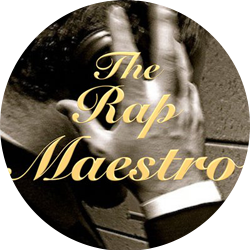So, I haven’t talked about Bizzy Bone of Bone Thugs-n-Harmony much in my writing not because I didn’t think he was good, but only because I didn’t know any of his stuff. Scratch that — I THOUGHT I didn’t know any of his stuff, but as it turns out, “Notorious Thugz” is one of my favorite songs from that B.I.G. album, and Bizzy is on it! I obviously knew Biggie started it off, but I didn’t realize the guy after him was Bizzy — I just thought it was some random Junior Mafia member, who do many of the other cameos throughout the rest of the album.
Anyway, “Notorious Thugz” is one of the most unique songs in Biggie’s entire catalogue, in my opinion, because his flow is so much quicker here than it is on almost every other song he made. The song is in a double-time flow, so the rapper either really has to rap slow to match the beat, or rap quickly, to act as a counterpoint to it. There kind of is no in-between here.
The fact that the beat is in double-time doesn’t just mean that the beat is slower, however. The fact that the beat is slower actually means that the rappers have MORE musical positions in which to place their notes. Bizzy Bone is an expert at realizing this and taking advantage of it, and I believe that this is what separates him from Twista. As the reader, Ehab, who requested this analysis said in his original e-mail to me:
>singing too fast doesn’t make you a goddamn skilled rapper but when it comes to Bizzy l’ve always felt something different and way complicated..
That “way complicated” part to Bizzy’s rap that Ehab mentions, I think, is Bizzy’s ability to place notes in multiple rhythmic positions, each of which have various rhythmic meanings, over a double-time beat. That sounds kind of complex, so allow me to explain. To talk about this more, let me make sure that we all know what a double-time beat is.
In normal, non-double-time rap music, there are 4 beats to a bar. Beats are like the minutes of musical time, in that they’re a building block for it. Just like 60 minutes make up an hour in everyday life, 4 beats make up a measure (another word for bar) in rap music. And we use beats, not minutes or seconds, to count music, because while we want minutes or seconds to always last the same amount of time so that everyone knows what we’re talking about when we use them, we want something else that can be fast OR slow in music, since some music is fast, and since some is slow.
In a normal bar of rap music, beats 1 and 3 are the strong beats, while beats 2 and 4 are the weak beats. Because of this, beats 1 and 3 generally have bass kicks land on them, while beats 2 and 4 have snares land on them. This gives the music a strong, propulsive feel.
Double-time music upsets this straightforward feel a bit. In double-time music, snares happen on the third beat of the bar, not the second, while bass kicks happen on beats 1, 2, and 4. This makes the music sound twice as slow as it should be, since snares are only coming half as often as they should; hence the term double-time. For example, this exact Notorious Thugz’ song could be notated in a 4/4 meter at 156 BPM (beats per minute, which is a mathematical measurement of tempo, the speed of a song), or in a 2/2 meter at 78 BPM. And if you’ll notice, the snares do happen on beat 3 on it, but the rappers respond to the lower division of the quarter note (another term for a beat.) You can use the website here to track those 2 BPMs on this song, if you’d like.
This is the paradox, then: there are simultaneously 2 very obvious layers of rhythm to double-time beats. Bizzy Bone takes musical advantage of this by sometimes rapping at the faster, 156 BPM level, and then slowing things down to the lower, 78 BPM level.
For example, check out Bizzy’s opening lines. They’re overall pretty fast, right? This means those opening rhythms are responding to that 156 BPM speed. But throughout the verse, he ends up slowing down the overall rate of his rhythms. Take a listen to his lines at 3:14, when he raps “Beg my pardon to Martin, baby we ain’t marchin’, we shootin'” His rhythms are much more slower, up-and-down, and almost march-like at that point. While he’s using this for expressive effect — to emphasize the poetic point he’s making — it also has musical consequences: here, he is now responding to that slower, 78 BPM level. He makes this shifts in rhythmic gear all over the place, and I would now encourage you to go out and find them yourself 🙂
He even mixes in a third rhythmic level at certain points, when he raps in a special type of triplet flow. At 2:37, he raps these words, where the accented syllables are in capital letters:
“DEEP in my TEMple and HAD to get”.
That’s a 3 over 2 polyrhythm, where the 156 BPM beat is divided into 2 8th notes, while Bizzy conversely divides it into 3. We can see this when we realize that every third syllable in those lines turns out to be emphasized: DEEP, TEM-, and then HAD. This means that his own rhythmic speed over that 156 BPM is actually 1.5 times faster than the beat behind him, since he’s placing 3 notes where the beat places only 2 eighth notes, and 3 divided by 2 is 1.5. So, 156 BPM times 1.5 is 234, and this adds a third rhythmic layer to the rap track. This is a complex rhythmic technique called metric modulation, which you can read more about on Wikipedia here.
That got kind of technical at the end, so let me try to paint a more descriptive picture. If I were to describe this more generally, just try to follow along to the structural markers of Bizzy’s phrasing. (Phrasing here refers to the building blocks of Bizzy’s melody, the sentences he raps and where they start and stop, but separated from their verbal meaning.) Bizzy is awesome because he makes his melody endlessly re-listenable, and we can enjoy his rap listen after listen by paying attention to:
1.) Where his phrases stop,
2.) Where his phrases start;
3.) How long or short his phrases are,
4.) etc.,
with regards to:
1.) The start of each bar 156 BPM bar;
2.) The start of each 78 BPM bar;
3.) The downbeat of each 156 BPM bar;
4.) The downbeat of each 78 BPM bar;
5.) etc.,
and so on…see just how deep this can get so, SO quickly?
Bizzy is constantly shifting the listener’s interpretation of the beat behind him, and trying to track him as he does this incredibly quick is really, really fucking amazing, haha. You’re right, that there is more to Bizzy as a Midwest chopper style, than some other people. This is because I think he realizes that, in rap, it’s not about the notes; it’s about the syllables. That is, his approach isn’t to try a rapid-fire triplet flow, like Twista does. He just thinks to himself, “Where should I put the syllables?” He imagines musical time like a malleable piece of clay, whereas other, less-talented rappers see it in a more clear-cut, almost woodblock-ish way, where YOU have to do what the MUSIC wants, not where YOU have the ability to make the MUSIC do what YOU want.
If you liked this article, you might enjoy these other ones, which are among my most popular:
1.) An analysis of Nas’ flow on the 2006 Busta Rhymes song “Don’t Get Carried Away,” which you can read here.
2.) My album review & analysis of the 2012 Kendrick Lamar album “good kid, m.A.A.d city,” which you can read here.
3.) A database of who the 23 most repetitive rappers in the industry are, available here.
4.) A study of every instrument Dr. Dre used on his songs between the years 2000 and 2009, online here.
5.) A breakdown of Eminem’s song “Business,” which you can check out here.


Bro, damn you just fucking hate on emcees you probably never even heard of an album from, yet you dickride emcees like Em who mostly took other styles past emcees you disrespected have mastered and came up with long before his cringeworthy Whitewashed stans believes he did first.
If you don't think Twista changes his flow, I recommend his 1st 2 albums, Adrenaline Rush and Kamikaze – and do analyses on them as soon as you can He changes it up on all his songs and frequently rides the hi-hats and melody lines of the production. You would be surprised how many Midland emcees have jacked his, and Bone Thugs N Harmony's styles of flows even in this generation.
In short, Bizzy rides the beat but is able to (Krazie does this as well!!) rap to a beat within the actual beat. He morphs his rhymes to end on cadence. Bizzy messes with your ear/mind by layering his rymes….Literally rapping the same verse over and over again but in slightly different tones each time. Before you know it he uses one of the tones (layers) and goes in a different direction as the others. When he does this your ear has to change directions to keep up with him. Genius.
#flowmotion
[email protected]
Agreed man! If you hit me up at [email protected], I'll get back at you with some chapters from my book that you might like, which are other examples of emcees like Talib Kweli rapping to beats-within-the-beat…hope to hear from you bro!
Peace,
Martin
nice
Thanks Anna! 🙂 I'm actually writing a bit of a follow-up to this piece, so if you want to see more about how we can not just understand but appreciate "fast" rappers, hit me up at [email protected]. That next article is about a guy named Scarub, thanks again!
Peace,
Martin